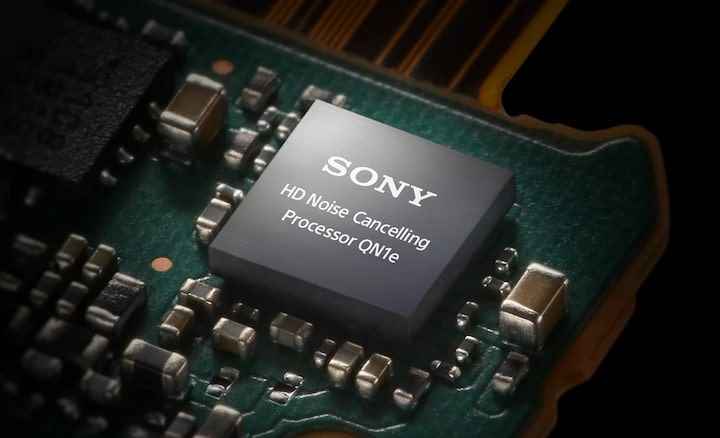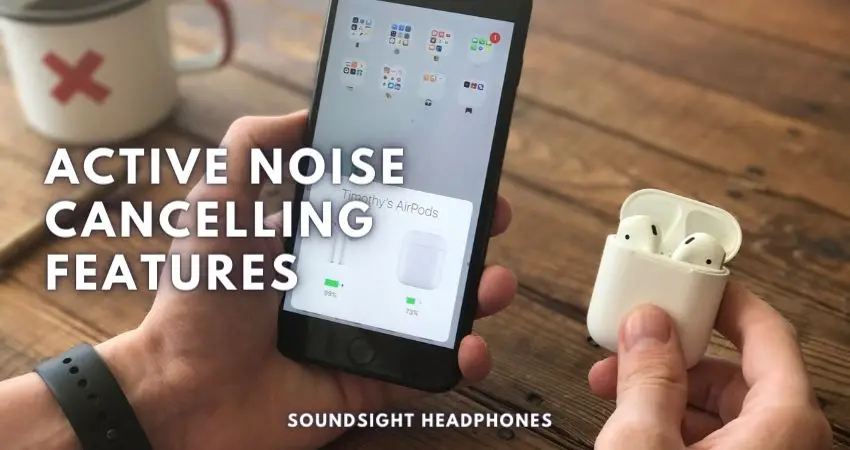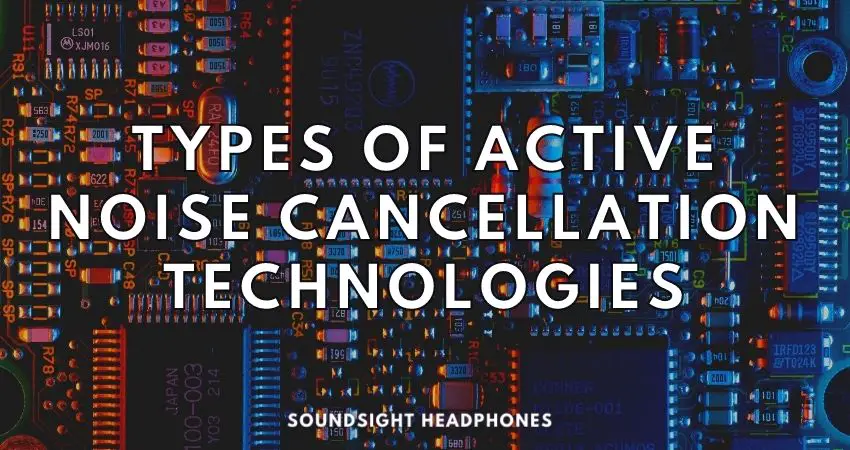ANC headsets are not just about noise cancellation, the type of ANC is just as important. There are currently three types of active noise cancellation technologies. To choose the right one, you need a solid understanding of what each technology provides, its benefits, and its shortcomings.
Who should read the article?
This article is not about active noise-canceling headphones used in the aviation, military or civilian markets. It is intended more for the general public, people who are interested in the types of active noise cancellation technology in stereo ANC headphones and their features, performance and benefits.
What are the different types of active noise cancellation?
Several types of ANC technologies have different pros and cons. We will look at each type individually:
Feedforward ANC
As most people know, Bose is responsible for developing the first Feedforward ANC technology. The principle of this technology is that microphones are placed inside the earpiece, facing outward, which picks up all relevant sounds and then transmits them to a computer unit or active noise cancellation circuitry. It then sends reverse sound waves into the speaker so that, when mixed with the original sound, they cancel each other; that’s how active noise-canceling is used to reduce any unwanted outside sounds that reach your ears.
Microphone arrays are often used to sense incoming noise waves from different directions, and signal processing can then cancel the noise wave out of the audible signal. Active noise-cancellation systems use two or more microphones. While the number of microphones is important to be high for an even directional canceling effect, it consumes more battery. It affects the listening experience as multiple electrical signals generate noise through distortion and frequency response alteration.
“If multiple noise sources are distributed in a wide area, the noise-reduction performance of the single-channel feedforward ANC system deteriorates. The causality constraint is that the unwanted acoustic noise propagates to the control point faster than the anti-noise. This problem occurs when some reference microphones are not sufficiently close to the noise source “ Source: https://www.mdpi.com/2076-3417/8/11/2291
The signals from the microphones are combined with a digital signal processing unit (DSP) or digital noise controller, which is placed in a box built into the headphones. This device helps cancel out unwanted ambient sounds, usually by using a Feedforward method that uses the microphone signals as a reference signal to calculate how much sound wave is reaching it and then sending signals back to cancel out parts of that sound wave at a specific frequency.
Advantages
- Feedforward ANC headphones are efficient and do not require much battery power.
- Most Feedforward ANC headphones use a single microphone (usually placed in the headband) and have a “clean” sound.
- They are less prone to distortion, making them ideal for music lovers.
- They work well in situations where you don’t need too much noise identification, such as at home or on the road.
Disadvantages
- Unlike Feedback active noise canceling headphones, Feedforward active noise-canceling headphones receive no information about how much noise is reaching the inside of the earpiece
- Feedforward ANC headphones are not the most effective in terms of noise attenuation, but they can still block out most ambient noise
- They don’t work well when you’re in noisy environments and windy conditions due to their inability to adequately capture high frequencies
- The direction of noise cancellation is limited by the position and number of the microphones. Noise may reach your ears before it is picked up by the microphones
- Wearing style has a small impact on the overall noise-canceling performance.
Why should you consider Feedforward active noise-canceling headphones?
Feedforward active noise canceling headphones are ideal for keeping your music at the center of your attention, even in noisy environments. They let you listen without worrying about background noise, except outside when the wind is blowing. You can turn off noise cancellation or adjust it dynamically if your headphones have adaptive noise cancellation and enjoy the best sound quality an ANC headphone offers.
A nice feature of this type of ANC headset is that the battery life is not as stressed as with hybrid ANC headphones, and there is no risk of white noise, microphonics, or distortion as with Hybrid and Feedback ANC technologies. You can use the ANC feature as much as you like and switch it on or off, as there is no feedback loop and no risk of losing the richness of the bass response.
Feedback ANC
Feedback ANC is similar to Feedforward ANC, but the difference is that the microphone is placed inside the headphones in front of the speaker (instead of behind it) and picks up extraneous sounds from there. The microphone placement inside the headphones mimics the way you hear sounds naturally.
The microphone then sends the sound to a computer chip that uses complex algorithms to reverse the noise and play it back to the speakers, creating a natural solution that requires a similar amount of circuitry as Feedforward systems. It has less noise attenuation and uses less power, as it generates anti-noise with lower sound pressure levels that match the originals’ intensity after they’ve been passively attenuated.
Noise generated by strong winds doesn’t cause problems anymore. People who prefer listening to music while outside will enjoy the benefits this active noise-canceling technology provides. They can focus on the content with no disturbance from unwanted noises or lack of uniformity. Sports earbuds with this noise-canceling tech are a must!
However, in the process of removing noise-canceling uniformity issues that Feedforward active noise canceling systems face, Feedback systems suffer from their own problems. A common issue with ANC feedback headphones is the microphone picking up the sound from music and then sending it back to the drivers, causing a ripple or feedback effect.
Advantages
- Feedback ANC headphones offer a very natural and uniform noise-canceling sound.
- It’s the most efficient noise-canceling technology compared to Feedforward and Hybrid ANC
- Headphones with Feedback ANC are the best when dealing with strong winds and other interferences such as sharp sounds or loud voices.
Disadvantages
- Feedback ANC systems are prone to feedback noise and can even amplify high-frequency noises via microphonics
- Music quality may suffer as the noise-canceling microphones accidentally alter the bass and mid-range sound response
- Ambient Listening Mode is not an option with feedback-based noise-canceling headsets unless they are equipped with separate microphones for this task
- Delay in noise detection and processing is a major problem with feedback ANC; while not always the case, significant delay can cause white noise and diminished noise cancellation
Headphones with ANC feedback
In general, headphones with active feedback noise reduction technology have the least need for Ambient listening mode or don’t have it at all. In-ear headphones and earbuds are the most prominent examples of this technology. Their small size also means they don’t need multiple microphones, and they usually use miniature MEMS microphones.
How to know if your headphones have feedback ANC
If you want to find out if your noise-canceling headphones work on the feedback principle, inspect how the headphones perform in windy conditions. If the wind doesn’t make any difference to the noise-canceling, your headphones rely on feedback rather than Feedforward ANC.
Another way to determine if you have a feedback ANC noise cancellation system is to listen to classical music you’re familiar with. If you hear a loud noise that is not supposed to be in your music when the ANC system is on, it is feedback noise generated when the microphones pick up a high-frequency sound. This is not a sure way to tell, but it can indicate a feedback ANC system.

Hybrid active noise canceling
The Hybrid ANC system is a combination of Feedback and Feedforward. Microphones are placed in the ear cups on both sides. The microphones on the outside (Feedforward) and the microphones on the inside collect different sounds, but the data is sent to the same noise cancellation controller.
The outside sound is suppressed first. The output and separate sounds captured by the inner microphone (Feedback) are then analyzed, and the “anti-noise” is optimized, creating an overall noise cancellation superior to the Feedforward ANC alone. This also creates a uniform noise cancellation effect but inherits the same drawbacks as Feedback ANC.
Because it combines the Feedforward and Feedback systems, the Hybrid active noise cancellation system uses more processing power and provides more powerful noise cancellation. Hybrid headsets are an excellent choice for travelers, but not so much for everyday use and audio enthusiasts, as the sound quality is not as good as headphones with Feedforward ANC.
Hybrid headsets are known for their effective noise cancellation. Still, because the microphones pick up similar sounds, the capturing and processing delay is a problem, resulting in constant white noise. In addition, the Feedback microphone is subject to feedback noise.
People often complain of short, high-pitched, shrill noises when using them. Some have returned the Sony WH-1000XM4 for this problem, which also occurs when the microphones are clogged with dirt, sweat, or even chalk that can accumulate in the ear cups.
Advantages
- These headphones offer the best noise-cancellation out of all three types of ANC
- Hybrid ANC is more convenient when traveling or working in the office
- Handles a broader range of frequencies, and the noise-canceling is more uniform than regular Feedforward ANC
Disadvantages
- Sound quality is not that great, and white noise is perceptible when listening to low volume music
- Hybrid headphones are the most expensive of all the three
- They’re prone to feedback noise
- Drains battery faster and shortens the battery lifespan faster
In one of their blog posts, Jabra points out that hybrid ANC headsets attenuate external sounds more effectively than any other type of noise cancellation, but require a higher level of expertise to design and implement.
It makes sense when considering that multiple microphones do not always mean better noise cancellation.
Microphone quality, fast processing power, an optimal number of microphones to reduce self-noise, and proper implementation require advanced technology, a high level of attention, and care to effectively cancel noise with a minimum of noise interference.
Best Hybrid ANC Headphones
Hybrid ANC headphones offer the most effective active noise cancellation, but it is beyond the scope of this blog post to discuss them in detail.
Headphones such as Bose QC45, Bowers & Wilkins PX7, and Bose QuietComfort Earbuds are high-quality examples of ANC headphones with the best hybrid active noise cancellation in the industry. I cover them more in-depth in a separate article, “Best ANC Hybrid Headphones.” LINK HERE

Settings & features specific to noise cancelling headphones
Any of the three active noise-canceling techs I’ve mentioned include some features or settings that improve user experience. Here are some of the features active noise-canceling headphones ANC have:
Adjustable noise cancellation
Some ANC headsets have an adjustable noise cancellation feature, which allows you to manually adjust the level of noise cancellation depending on your conditions and task. These headsets allow you to set a noise cancellation level, which determines how much noise is canceled, rather than using the feature at full power all the time.
The advantage of adjustable noise cancellation is that you can minimize some of the drawbacks of the noise cancellation system. With automatic noise adjustment, the lower the ambient noise level, the less power the headset consumes. This feature is especially useful for hybrid headsets.
In the case of the hybrid ANC system, by reducing the noise cancellation, you also reduce the amount of audio distortion caused by white noise. This can be useful if you want to enjoy music while remaining protected from ambient noise.
Adjustable noise-canceling headphones are generally more expensive than their noise-canceling counterparts. This is the case with the Bose 700 Active Noise Cancelling headphones, which allow you to set a noise cancellation level from 0 to 10. At level 0, there's no noise cancellation at all; instead, you activate Transparency Mode.
In essence, headphones with an adjustable noise-canceling feature are not different from the three ANC technologies I talked about, but the user has access via a mobile app to the digital signal processing unit to make it customizable. A more intuitive approach to adjustable noise cancellation is adaptive ANC.
Adaptive noise cancellation
Adaptive noise cancellation headsets have the unique property of adjusting noise attenuation based on the source and environment of the noise. These headsets typically have DSPs and an array of sensors, such as accelerometers and microphones, that monitor the acoustic environment and suppress noise based on its impact on the user.
Sony noise-canceling headsets typically feature NC Optimizer technology that analyzes your environment, the shape of your head, how the headset is placed on your ears, and whether you are wearing glasses. It can also analyze the altitude based on atmospheric pressure to determine how much noise cancellation you get when traveling by plane.
Transparency mode
Transparency Mode or Ambient Sound Mode is not a noise cancellation technology but a feature present in most headsets with noise-canceling. Contrary to the active noise cancellation mode, in Transparency Mode, users receive sounds from the outside to enhance their surrounding awareness.
The transparency mode feature can be incredibly useful when you’re crossing a busy street when you need to focus on the traffic and not your music. It’s commonly implemented in office headsets, sports earbuds, and travel headphones.
Not all headphones with noise-canceling have a transparency mode. When they do, it is generally done through microphones outside the ear cups to allow ambient noise to be fed into the system. If transparency mode isn’t present, you’re probably dealing with a Feedback noise-canceling headphone.
FAQ about ANC headset types
Which type of ANC is the absolute best?
It’s hard to say because each type behaves differently, and you won’t get the best performance from all models. Hybrid ANC, the one with the best noise-canceling performance, also has flaws: energy-intensive, white noise, feedback noise, constant hiss, and altered bass response.
Knowing that every type of ANC has its advantages and disadvantages, you should decide which is the best for your lifestyle. I plan to address this in a future article because every type of ANC technology is different and must be treated as such. The link will be here: LINK HERE.
What is the most efficient ANC headphone on the market?
The most efficient ANC headphone available is the Sony WH-1000XM4, which uses hybrid ANC technology. It has the best noise cancellation, reducing noise up to -30 dB. Other powerful noise-canceling headphones follow: Sony WH-1000XM3, Bose QuietComfort 35, Bose 700, Wilkins PX Wireless & Apple AirPods Max, and Bowers.
These headphones offer a great noise reduction across all frequencies and consistent performance. The Sony WH-1000XM3 is much more efficient and cost-effective than XM4, but overall they all block mid-tones and low noises. The Sony WH-1000XM3 is a great choice for plane travel, trains, and office. Similar to WH-1000XM4, they also use a hybrid approach to noise-canceling, which is why they’re in the $100-$200 price category.
What algorithms do noise-canceling headphones use?
Generally, headphones that employ active noise reduction (ANR) use Least Mean Square (LMS), Filtered-X LMS, or Normalized Least Mean Squares (NLMS) algorithms. These are fundamental algorithms in signal processing and are used to cancel a wide range of signals.
The difference between ANC technology and algorithm is that technology refers to the system, the design behind the electronics, and circuitry. In contrast, the algorithm is a set of instructions and steps that generate the anti-noise signals.
What is ENC (environmental noise cancellation)?
Environmental Noise Cancellation is just a fancy term for passive noise reduction. Passive noise reduction is achieved by reducing or attenuating ambient noise by physical means. It is not technological, does not actively cancel noise, and does not require processing power like ANC headsets.
A good tight fit and dense ear pads that create an airtight seal are the basics for passive noise reduction. That’s it.
How do passive headphones compare to ANC?
Passive headphones can often provide a similar level of noise reduction to ANC technology. However, there is a big difference between the two:
ANC technology requires a signal processor and the power to run it. Noise-canceling microphones are better suited to cancel a narrower range of frequencies.
Headsets with passive noise reduction employ acoustic sound insulation materials that provide substantial noise reduction in the higher frequency ranges.
Conclusion
Overall, headphones with active noise reduction are ideal for reducing the everyday background noise that can sometimes interfere with music listening. But purchasing such headphones requires a minimum of knowledge and understanding of the ANC technologies available.
I hope you’ve enjoyed this article and discovered the specific features of each noise reduction technology. If you didn’t find something clear, feel free to comment below.
On the same subject of ANC and noise-canceling headphones, you can also check this article: LINK HERE
What do you think is the best active noise cancellation technology?
